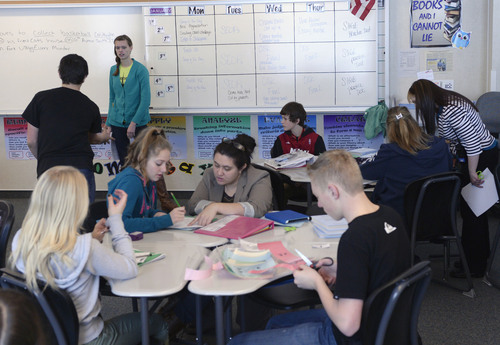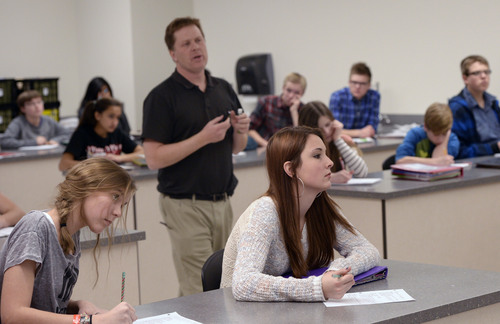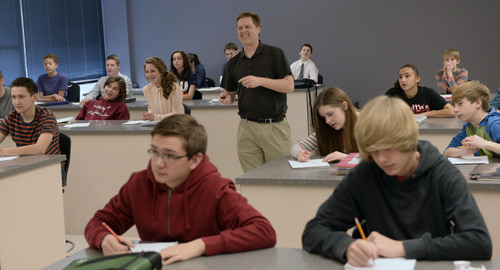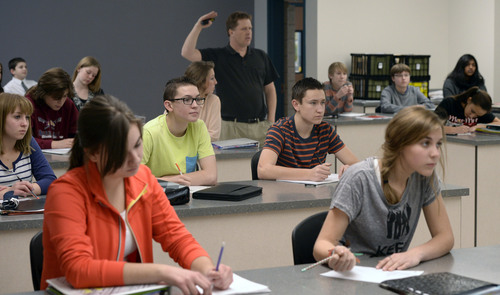This is an archived article that was published on sltrib.com in 2014, and information in the article may be outdated. It is provided only for personal research purposes and may not be reprinted.
When lawmakers decided to boost per-pupil spending last year by 2 percent, many Utahns cheered, envisioning that cash raining on teachers and classrooms.
In reality, much of that money was spoken for — by the state retirement system — long before it ever hit schools, a Salt Lake Tribune investigation has found.
In the Salt Lake City and Alpine school districts, not one cent of the increased student funding made it into classrooms. All of it went to the state retirement system and/or rising health care costs.
It's a pattern that could repeat this year unless lawmakers find more money per student than what's so far been proposed.
Gov. Gary Herbert has proposed boosting basic per-pupil funding — known as the weighted pupil unit (WPU) — by 2.5 percent for next school year. It will be up to lawmakers whether to fund that proposal.
But Sharon Gallagher-Fishbaugh, Utah Education Association (UEA) president, said 2.5 percent won't mean new resources.
"We will have nothing," she said. "It will maintain current funding levels."
Jen Jacobs, a fifth-grade teacher at Bell View Elementary in Sandy, said it's a common misconception that increases to per-pupil spending mean automatic raises for teachers or additional resources for classrooms.
It's been a topic of debate at her own family's Sunday dinners, she said.
"People hear that and think, 'Oh, teachers are going to get a big raise,' and that's really not the truth" when it comes to WPU gains, said Jacobs, who also is vice president of the Canyons Education Association. "That's money that goes toward the increased costs of doing business."
—
Diverted 'pupil' spending • Lawmakers last year upped the value of the WPU to $2,899 per student from $2,842.
That number doesn't cover the entire amount Utah spends per pupil, but unlike other pots of money, schools can spend WPU dollars on almost anything. In all, lawmakers put about $166 million in new money toward education for this school year, including through the WPU.
But retirement and health care costs advanced almost as fast — leaving many school districts with little of that additional WPU money in hand.
And Utah still has the nation's lowest per-pupil funding.
"Regretfully, the cost of doing business continues to go up, so as a whole, when we're looking at those WPU increases, we're hoping they offset our cost increases," said Ben Horsley, Granite District spokesman, "and when they do, we're grateful, and when they don't, we have to cut programs."
Granite, for example, received $4.9 million in additional WPU money for this school year. But it also had to pay an additional $3.9 million into the state's retirement system.
The Jordan District found itself in a similar situation. Giving all of its employees 1 percent raises would cost $2.1 million, said district spokesman Steve Dunham.
The district got $3.8 million more through the WPU, but $2.5 million of that went to the state's retirement system. That left Jordan about $1.3 million, which helped the district open its new Copper Mountain Middle School in Herriman and pay for other needs, said Sandy Riesgraf, a district spokeswoman.
Canyons did give its employees more money this year, but the WPU didn't come close to covering that expense. The district received an additional $2.7 million from the WPU bump, but had to pay another $1.7 million into retirement.
The $5.2 million for employee raises came largely from local property tax revenue, said Leon Wilcox, the district's interim business administrator.
"It's tough to give a big cost-of-living adjustment to all your employees," Wilcox said, "because we have to pay so much in the Utah Retirement Systems."
—
A double drain • In fact, the majority of this year's statewide increase to the WPU — about 60 percent — was eaten up by retirement cost increases, said Bruce Williams, state associate superintendent.
Why? Largely to make up for losses the retirement system sustained during the recession, said Dee Larsen, legal counsel for the Utah Retirement Systems.
Each school district must pay a percentage of eligible employees' salaries into the retirement system, which then funds teachers' pensions after they retire. For the past several years, the districts' required contributions have been steadily rising.
Last year, for example, districts had to kick in 18.8 percent of many employees' salaries to the system. This school year, that jumped to 20.5 percent.
Though next year's rate has not yet been finalized, it's expected to swell again. Larsen said the hope is that the rate will stabilize after that and eventually decrease.
Many districts also saw health insurance increases.
Alpine School District, the state's largest district, got about $6.4 million in additional WPU money this school year. But it had to pay $2.8 million more into the retirement system and nearly $4 million more toward health insurance costs — consuming about $400,000 more than the WPU increase.
Williams said health insurance costs have generally been rising about 8 percent to 10 percent a year, though that has hit districts in different ways. Some districts, such as Granite, fund their own health insurance plans, and Granite faced no increase this year. Most, however, go through insurance carriers.
"It would have been difficult for them to give significant increases [to employees]," Williams said of districts, "unless they had other revenue sources beside the WPU."
—
Getting back on track • Laura Black, Canyons Education Association UniServ director, called the 2.5 percent WPU increase proposed by the governor "a start."
But she said 2.5 percent is still not enough.
"The increase they're proposing in the WPU will barely cover increases in the retirement and Social Security [costs]," said Black, who is also a former Democratic lawmaker.
With no WPU increase, as Horsley notes, schools would likely have to make cuts to existing programs to continue paying for retirement and health care costs.
No one denies it's an issue.
Senate budget chairman Lyle Hillyard, R-Logan, said he'll have a better idea of how much lawmakers might boost the WPU when state revenue estimates are updated in February.
He realizes increasing the WPU by only a couple of percentage points won't do much for classrooms or teachers.
"If we fund a 2 percent increase to the WPU, it will basically all go toward health insurance and retirement," Hillyard said. "If we fund less than 2 percent, [school employees] are going to take a cut in their pay stubs."
Funding enrollment growth alone for next school year will cost more than $60 million, he notes. On top of that, every 1 percent increase to the WPU costs about $25 million.
Still, Hillyard said, he hopes to boost salaries for public employees and teachers.
The UEA believes a 4 percent increase to the WPU is needed each year for the next three years and on top of other increases to start getting Utah education back on track to where it was financially before the recession.
The state school board is asking for a 2.7 percent increase to the WPU, which board chairman Dave Crandall said could offset some higher costs while still providing a 1 percent raise for teachers and administrators.
Juliette Tennert, budget director in the Governor's Office of Management and Budget, said Herbert recommended the 2.5 percent increase based on estimated revenue increases from November.
"We're always working within a constraint of new revenue available," Tennert said.
Jacobs, the fifth-grade Bell View teacher, said she's grateful for any increase. But she hopes Utahns understand that not every increase to the WPU means better days for teachers and classrooms.











